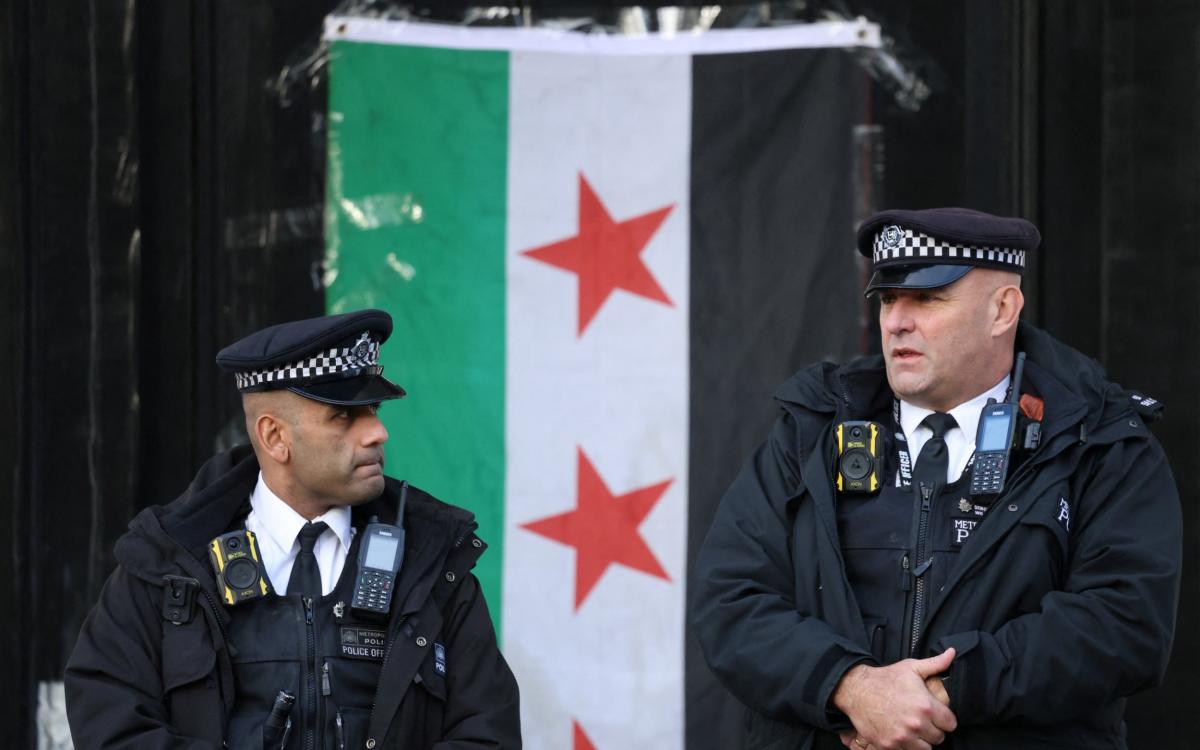Supporters of the rebels who ousted president Bashar al-Assad have entered Syrian embassies around the world to tear down the old order’s two-starred Syrian flags, which had been the country’s official banner since 1980.
A green-white-black horizontal tricolour adorned with three red stars, which was first adopted in the pursuit of independence from France in the 1930s, has been used by the opposition as its main symbol.
On Monday, two police officers stood guard outside the Syrian embassy in London after a three-starred rebel flag was left attached to the front door.
The day before, a crowd outside the building demanded the removal of the Assad regime flag, which remains atop the pole above the entrance.
The rebel flag has also been unfurled from a window at the embassy in Madrid and raised at the embassy in Moscow, the city to which Bashar al-Assad has reportedly fled.

Iranians brandish the Assad regime flag in front the Turkish embassy in Tehran – ATTA KENARE/AFP via GETTY IMAGES
When Syria gained its independence from France in 1946, the three-starred flag was formally incorporated and later enshrined in Syria’s constitution.
The flag was dropped when Syria joined Egypt to create the United Arab Republic in 1958.
The myriad of rebel groups and opposition leaders who toppled the Assad regime have rallied under the country’s former “independence flag” to present a unified coalition and announce to the world that political change was coming in Syria.
A group of men stood on a balcony at the Syrian embassy in Moscow, clapping and singing as they raised the opposition flag on Monday.

Syrians in Berlin celebrate – ANADOLU
“Today the embassy opened and is working normally under a new flag,” an embassy representative told TASS, the Russian state news agency.
Syrians flocked to the main square of the capital Damascus to unfurl a large three-starred flag, while supporters the world over have turned out in public to celebrate under the new flag.
On Sunday, supporters of the rebels also raised the opposition flag at the Syrian consulate in Istanbul and at the Syrian embassy in Athens, where police detained four people but left the flag flying.
In Madrid, about 150 people cheered as a man in the Syrian embassy threw the Assad regime flag to the ground and replaced it with the independence flag.

Scene in the town of Majdal Shams in the Golan Heights – MOSTAFA ALKHAROUF/ANADOLU via GETTY IMAGES
The three-starred rebel flag has also been spotted at Syrian embassies in Riyadh, Belgrade, Stockholm, Kuala Lumpur and Tokyo.
A definitive shift away from the Assad regime flag has also taken place online, with a number of Syrian embassies changing their profile pictures to the new flag, such as Stockholm, Kuala Lumpur, Nicosia, Tunisia, Sofia, Athens, Cairo and Jakarta.
Online, there has also been a groundswell of Syrians posting the new flag, coupled with mounting calls for technology companies to update the Syrian flag emoji.
Manal al-Assad, wife of Maher [younger brother of Bashar al-Assad], and Rami Kaazour, the singer of a Bashar al-Assad protest song, are among those using the independence flag to declare online their allegiance to the new Syria.
Upon the creation of the United Arab Republic in 1958, a red-white-black tricolour with two green five-pointed stars was adopted as its national emblem.
The Ba’ath party added another central green five-pointed star to the flag when it came to power in 1963, before abandoning the stars in favour of the hawk of Quraish in 1972.
In 1980, then-president Hafez al-Assad adopted the United Arab Republic’s red-white-black tricolour with two green five-pointed stars for the Syrian national flag.
Each colour of the Assad flag had a meaning: red stood for the blood shed in the fight for freedom, white meant a peaceful future, black symbolised oppression faced by Arabs and the green stars represented Syria and Egypt as founding members of the republic.
Broaden your horizons with award-winning British journalism. Try The Telegraph free for 3 months with unlimited access to our award-winning website, exclusive app, money-saving offers and more.

